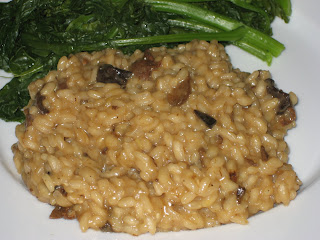
I made
this recipe a couple of weeks ago on the first weekend of fall. I wanted to make something that would officially kick off the autumn season, and this cake seemed like just the thing.
At it's core, this is a simple spice cake with a hefty dose of apples and rasins folded into the batter. Actually, since the cake is cooked in a
Bundt pan, it doesn't have a core at all, but you know what I meant.
To get the full "fall in New England" effect, I used
Cortland apples grown in my own town at the 130-year-old
Mann Orchards. The Book calls for "3 Cortland or Empire apples, peeled and cut into 1/4-inch dice." At first, this doesn't seem like too difficult a request, but about halfway into the second apple, my hand started cramping up, and I just couldn't handle the dicing anymore. So, recipe instructions notwithstanding, my cake contained "1 1/2 Cortland apples cut into 1/4-inch dice" and "1 1/2 Cortland apples coarsely chopped." I know, I know, I'd be kicked out of Le Cordon Bleu or the CIA for corner cutting like that, but, as you'll see in a moment, the lack of uniformity in apple pieces was the least of this cake's problems.

The Book says to butter and flour a 12-cup Bundt pan, knocking out excess flour. Because I have a non-stick Bundt pan, I blithely ignored this instruction, saying to myself that it only applied to those suckers who don't have a non-stick pan. I guess I'm the sucker after all. As the cake cooked, it filled the whole house with its intoxicating apple-cinnamon-nutmeg aroma (maybe the tablespoon of dark rum in the batter also had something to do with the intoxicating quality of the aroma?). Once the cake had cooked for the prescribed time, I took it out of the oven an put it on a rack to cool in the pan for a while.

When it came time to turn the cake out of the pan, things went south pretty quickly. I ran a knife around the edge of the pan to loosen the cake, but when I flipped it over, nothing happend. I tapped the bottom of the pan gently. Still nothing. I tapped a little less gently. Nothing still. So, with some foreboding, I began to shake the pan somewhat vigorously until the bottom half of the cake plopped onto the cooling rack while the top half remained firmly in place in the pan. This whole experience was reminiscent of the unfortunate
Blueberry Almond Coffee Cake incident. Thankfully, I wasn't making this for guests, so it didn't matter that it wasn't pretty. And even though it wasn't going to win any beauty contests, it sure was good.
We really liked the flavor and texture of this cake, and we loved having it on hand for snacking througout the week. The blurb in The Book says that it's great to pack in lunchboxes. Hear, hear! I'll probably make it again, but when I do, I'll add some chopped walnuts to the batter because, while apples and raisins are a great duo, walnuts really are the third musketeer in this scenario, aren't they? Also, the
blurb on epicurious notes that the recipe comes from
Richardson’s Canal House Inn in Pittsford, New York, where it is served with caramel sauce. The Book doesn't mention the caramel sauce, however, and it wasn't until I was eating the cake that it sruck me that caramel would have been a natural and welcome accompaniment.
Date Cooked: September 20, 2008
Degree of Difficulty: Medium
Rating: A-













